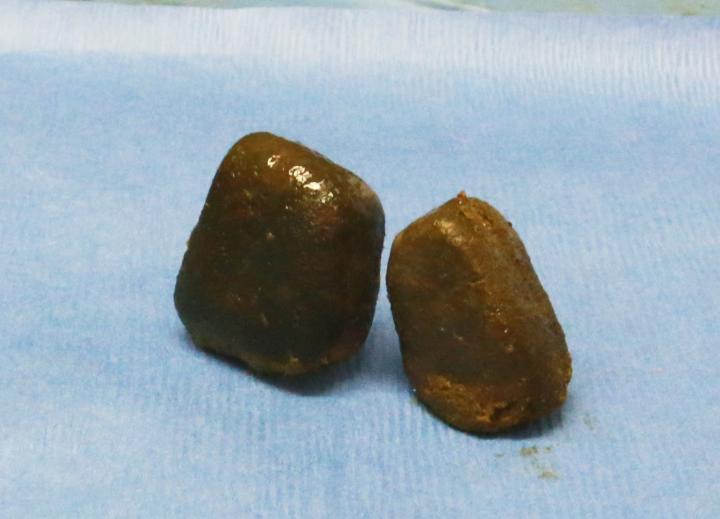The world makes more sense today, thanks to new research detailing the digestive processes responsible for the bare-nosed wombat’s incredible cube-shaped poop.
Nature can be so magical.
For reasons not entirely understood, the bare-nosed wombat (Vombatus ursinus), a plant-eating Australian marsupial, produces poop roughly the same shape and size of dice. New research published in Soft Matter (great name) suggests this oddity of nature is no accident and that wombats have evolved highly specialised digestive capabilities to make it happen.
Bare-nosed wombats have what can only be described as an intense and intimate relationship with their excrement. The critters produce anywhere between four to eight pieces of dung during a single go, each measuring around 2 centimeters across. These sessions are unusually frequent, as wombats can yield upwards of 80 to 100 cubes of poop across a single evening.

But that’s not the end of it. Wombats collect their poop, placing the pieces ever-so-carefully around their home range. Scientists suspect this assists with intraspecies communication, either to mark territory or, ahem, attract mates (something to think about when the clubs re-open). An advantage of cube-shaped poop is that it doesn’t easily roll away, in what is a popular, yet unproven, theory to explain the unique phenomenon.
There’s more, because of course there is. We humans, because we’re normal, deposit the digested remnants of our meals around a day or two after eating. Wombats, being the weirdos that they are, have digestive cycles that are up to four times longer than ours. This added time means they’re very efficient at extracting nutrients and water from their meals.

Patricia Yang, a postdoctoral fellow in mechanical engineering at the Georgia Institute of Technology and a co-author of the new study, has been studying wombat poop for a few years now. Back in 2018, her team was the first to show that wombat faeces acquire their cube shape at the end of the large intestine, not at the very beginning (as previously believed) or at the very end of the process (no, wombats don’t have square buttholes). The team discovered elastic properties in the wombat’s intestinal wall, but some questions remained.
“The ability of the wombat’s soft intestine to sculpt flat faces and sharp corners in faeces is poorly understood,” explained Yang in an email. “In 2018, we found differential [contrasting] stiffness in the intestine, but we did not understand how two stiff regions make four corners. It turns out the differential stiffness and contraction make it possible.”
To reach this conclusion, the team combined experimental research with number crunching, devising a mathematical model that demonstrates how a circular rubber band with two stiff regions can contract to four corners while in a “highly damped environment,” as the authors wrote in the study.
The researchers had recently discovered two stiff and two flexible regions wrapped around the circumference of the wombat intestine. Equipped with their updated anatomy, the team, which includes David Hu, a professor of fluid mechanics at the Georgia Institute of Technology, created 2D computer models that simulated the expansion and contraction of these regions, demonstrating how the poop forms in this part of the animal’s bowels, which is located within the last 17% of the large intestine.
“Muscle is like a rubber band,” explained Hu in an email. “The stiffer the rubber, the quicker and more strongly it contracts. Now imagine a big rubber band constructed with two stiff sections and two soft sections in an alternating ABAB pattern. When that composite band contracts, the stiff sections will contract first. The centre of the stiff sections forms the first pair of corners of the square, as they are on the diagonal.”
So when the stiff parts of the “rubber band” contract, the soft sections are left behind, and those lagging points become the remaining pair of corners of the square, he said.
“Poop is hard to move because it’s so dense and stiff,” said Hu. “The contractions are very subtle, and these corners get more and more accentuated over 40,000 contractions that the faeces experiences as it travels down the intestine.”
That’s a lot of contractions to produce a single piece of cube-shaped poop. For the wombat, it must be worth all the trouble.
This research might seem superfluous, but advances in this area could be applied elsewhere, including the early detection of colon cancer in humans. As Yang explained in a statement, “one of the early symptoms of colon cancer is that part of the colon can become stiff,” potentially producing an “edge or unusual shape in the faeces and could be an early indicator about the health of the colon.”
As a final fun fact, Yang and Hu are the recipients of not one but two Ig Nobel prizes, an annual award for research that “makes you laugh then think.” In 2015, the team won the satirical prize for research into animal urination (the scientists discovered that all mammals, regardless of size, take about 21 seconds to pee), and in 2019 they won the Ig Nobel for their earlier work on wombat poop.
